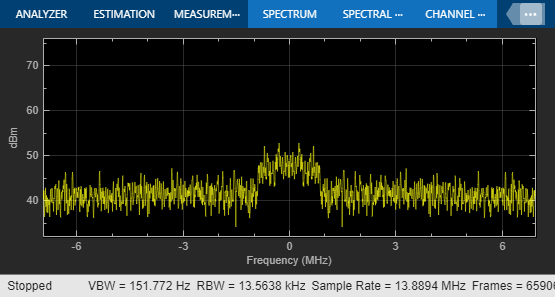Wireless Digital Video Broadcasting with RF Beamforming
This example shows how to model a digital video broadcasting system which includes a 16 antenna phased array receiver operating at 28 GHz. The baseband transmitter, receiver and channel are realized with Communications Toolbox™. The RF receiver is implemented with the RF Blockset™ Circuit Envelope library, and the receive phased array antennas are constructed using Phased Array System Toolbox™. The 4 x 4 planar phased array feeds a 16 channel receive module that includes phase shifters to enable RF beamforming.
System Architecture
The system consists of:
A Baseband Transmitter subsystem that is responsible for generating a 64-QAM signal occupying 2 MHz of bandwidth that adheres to the DVB-C standard.
Channel effects in the form of path loss.
A 16 element phased array receiver arranged in a 4 X 4 rectangular grid. This includes design parameters for operating frequency, element radiation pattern, and receive direction.
An RF receiver module consisting of 16 paths combined with a network of 2:1 power combiners and then downconverted to baseband. Each path includes LNAs and variable phase shifters for RF beamforming. The network of 2:1 power combiners is constructed twice to emulate a typical design process. The initial design employs ideal Wilkinson power dividers as behavioral combiners, while the second implementation uses actual hardware modeled with
S-Parametersblocks and measured data supplied via a Touchstone™ file (wireless.s3p).
A Baseband Receiver subsystem that is responsible for extracting the transmitted signal. The receiver includes simple models for correcting phase offsets and gain control effects.
Diagnostics are available at various stages in the system using the received constellation, the bit error rate calculation, and the received spectrum.
model_ideal = 'simrfV2_wirelessdvb_beamform_ideal';
open_system(model_ideal)
sim(model_ideal)



Designing with Ideal Components
An initial design may use ideal components to speed up the overall design process. For example, ideal Wilkinson dividers from the RF Blockset Junctions library can be used to build a combiner system in the Receive Antenna Array. This combiner system can be consolidated into a 17-port S-parameters block to improve simulation performance. A simplified example of consolidation is shown where the 4:1 combiner system on the left is replaced with the 5-port S-parameters block on the right. The S-parameters block entries are calculated in the WilkinsonTypeCombiner block mask initialization commands.
model_combiner = 'simrfV2_wirelessdvb_beamform_prototype_combiner';
open_system(model_combiner)

Each input channel branch of the RF Receiver employs a separate amplifier to introduce thermal noise and non-linearities. The quadrature demodulator following the combiner performs direct downconversion and includes its non-linearities, LO leakage, I/Q mismatch, and noise impairments.
open_system([model_ideal '/RF Receiver'], 'force')

bdclose(model_combiner)
bdclose(model_ideal)
clear model_ideal
Designing with Real Components
Use S-Parameters blocks to model a real combiner system. There are several options available to characterize the behavior of each individual block in the combiner system; one approach utilizes a data file directly while another approach provides a rational model of the data. For the latter approach, utilize the rational function in RF Toolbox™, save the resulting parameters in the base workspace and use them in the S-Parameters blocks. For this example, the measured data is described in the Touchstone file wireless.s3p and used directly. To improve simulation performance the combiner system is replaced with a 17-port S-Parameters block. The S-Parameters block entries are calculated using the function simrfV2_wirelessdvb_beamforming_findcombinerspars in the Initization commands of the RF Receiver subsystem mask.
model = 'simrfV2_wirelessdvb_beamforming';
open_system(model)
sim(model)



The transmit side planar array is chosen to have 16 elements and transmits along the main beam (azimuth = 0 deg. and elevation = 0 deg.) at a frequency of 28 GHz. An isotropic radiation pattern is chosen for each element. Note that the power dividers introduce a phase shift at 28 GHz. This is estimated and corrected in the Baseband receiver subsystem.
Modify the Receive Direction and Simulate
Modify the receive direction by changing the Receive Direction mask dialog parameter of the 16-element Receive Antenna Array. The angle chosen decreases the signal strength due to the proximity of a null in the array radiation pattern.
open_system(model) set_param([model '/Receive Antenna Array'],'RecDir','[20;25]') sim(model)


Improve RF Reception with Beamforming
Modify the Beamforming direction parameter for the 4 X 4 phased array on the receive side. This mask parameter will automatically adjust the phase shift of each channel in the RF Receiver subsystem. Run the simulation to observe an increase in the received signal level.
open_system(model) set_param([model '/RF Receiver'],'BeamDir','[20;25]') sim(model)


bdclose(model)
clear model
References
S. Emami, R. F. Wiser, E. Ali, M. G. Forbes, M. Q. Gordon, X. Guan, S. Lo, P. T. McElwee, J. Parker, J. R. Tani, J. M. Gilbert,, and C. H. Doan, "A 60 GHz CMOS Phased-Array Transceiver Pair for Multi-Gb/s Wireless Communications," in IEEE Int. Solid-State Circuits Conf. Tech. Dig., Feb. 2011, pp. 164-165